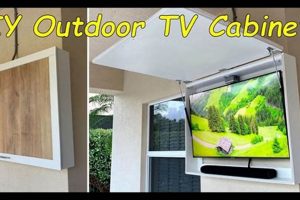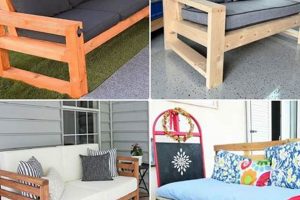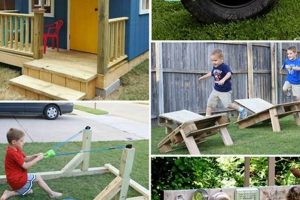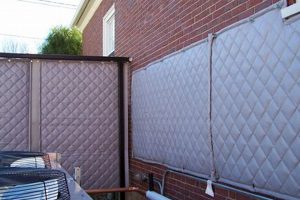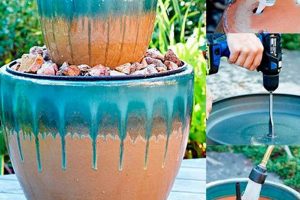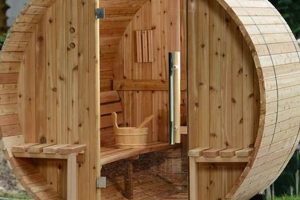The construction of a seating structure for exterior use, crafted from timber by an individual, constitutes a practical application of woodworking skills. Such projects typically involve selecting suitable wood, cutting it to size, and assembling the components to create a functional and aesthetically pleasing bench. For example, a homeowner might build a simple slatted bench for a patio or a more elaborate, backrest-equipped seat for a garden.
Creating such a structure offers several advantages, including cost savings compared to purchasing pre-made furniture, the opportunity to customize the design to specific spatial needs and aesthetic preferences, and the satisfaction of creating a useful object. Historically, this type of construction has been a common practice for individuals seeking affordable and personalized outdoor furnishings, utilizing readily available materials and basic tools.
The subsequent discussion will delve into various aspects of creating these structures, encompassing wood selection criteria, design considerations for durability and comfort, joinery techniques appropriate for outdoor environments, and essential finishing processes to protect the wood from weathering and decay.
Essential Guidance for Timber Seating Construction
The following recommendations offer practical advice for ensuring the successful construction of robust and aesthetically pleasing exterior seating structures using timber.
Tip 1: Wood Selection is Paramount: Opt for naturally decay-resistant wood species such as cedar, redwood, or pressure-treated lumber. This selection minimizes the need for excessive chemical treatments and extends the lifespan of the structure.
Tip 2: Prioritize Structural Integrity: Employ robust joinery techniques like mortise and tenon, or lap joints reinforced with exterior-grade adhesives and screws. Secure connections are crucial for withstanding weight and environmental stresses.
Tip 3: Design for Water Runoff: Incorporate slight slopes or spacing in the seating surface design to facilitate water drainage. Accumulated water promotes rot and weakens the wood over time.
Tip 4: Implement a Thorough Finishing Process: Apply multiple coats of a high-quality exterior wood sealant or stain with UV inhibitors. Proper finishing protects the wood from moisture, sunlight, and fungal growth.
Tip 5: Hardware Considerations: Use stainless steel or galvanized hardware to prevent rust and corrosion. These materials are designed to withstand prolonged exposure to the elements.
Tip 6: Regular Maintenance is Key: Periodically inspect the structure for signs of wear, damage, or decay. Promptly address any issues to prevent them from escalating.
Tip 7: Consider Ergonomics: Design the bench with a comfortable seat height and depth, and consider adding a slightly angled backrest for enhanced support. The seating should be functional and inviting.
Following these guidelines will contribute significantly to the longevity, stability, and aesthetic appeal of the timber seating structure, ensuring years of reliable service.
The subsequent sections will address design variations and advanced construction techniques for enhancing the functionality and visual appeal of these outdoor furnishings.
1. Wood Species Selection
The selection of wood species is a foundational element in the successful creation of an outdoor seating structure. This choice directly influences the durability, aesthetic appeal, and overall lifespan of the finished product. The inherent properties of different wood types dictate their resistance to environmental factors such as moisture, sunlight, and insect infestation. For example, using untreated pine in an outdoor application would lead to rapid decay, rendering the structure unusable within a short period. Conversely, employing naturally decay-resistant species, like cedar or redwood, or pressure-treated lumber, significantly enhances the structure’s longevity. The selection process should, therefore, prioritize species known for their suitability in outdoor environments.
Considerations beyond durability also play a crucial role. The grain pattern, color, and texture of the wood contribute to the visual appeal of the bench. For instance, redwood offers a rich, reddish hue and distinctive grain, while cedar presents a lighter, more uniform appearance. The choice should align with the desired aesthetic and the surrounding environment. Furthermore, the wood’s workability affects the ease of construction. Softer woods are easier to cut and shape, but may be less resistant to wear and tear. Harder woods provide greater durability but require more specialized tools and techniques.
In summary, the selection of wood species is not merely a matter of preference; it is a critical determinant of the success or failure of a seating construction project. Understanding the properties of different wood types and their suitability for outdoor applications is essential. A thoughtful choice, balancing durability, aesthetics, and workability, will result in a long-lasting and visually pleasing addition to the outdoor space. Failure to adequately consider these factors can lead to premature failure and significant material waste.
2. Joint Strength
The durability and longevity of a seating structure depend critically on the strength of its joints. Insufficient joint strength leads to structural failure under load or environmental stress, rendering the bench unusable and potentially unsafe. A poorly constructed joint represents a weak point in the overall design, susceptible to separation or breakage over time. For example, a bench assembled with inadequately sized or improperly secured screws might collapse under the weight of multiple occupants or during exposure to strong winds.
Various joint types are employed in seating construction, each offering different levels of strength and requiring specific construction techniques. Mortise and tenon joints, known for their robustness, provide a large surface area for gluing and mechanical interlocking, making them well-suited for load-bearing connections. Lap joints, where two pieces of wood overlap and are fastened together, offer a simpler alternative, but may require additional reinforcement for heavy use. The selection of an appropriate joint type depends on factors such as the wood species used, the anticipated load, and the complexity of the design. Ignoring these considerations can result in a structurally unsound seating structure.
Therefore, meticulous attention to joint design and execution is paramount in building a long-lasting bench. Proper joinery techniques, combined with the use of high-quality adhesives and fasteners, are essential for achieving the necessary strength and stability. Furthermore, regular inspection of the joints for signs of wear or loosening is crucial for maintaining the structural integrity over time. Ultimately, the investment in sound joinery practices translates directly into the safety, reliability, and extended lifespan of the finished seating.
3. Weather Resistance
The integration of weather-resistant design and materials is paramount in any seating construction project intended for outdoor placement. External seating is invariably exposed to a range of environmental stressors, including precipitation, ultraviolet radiation, temperature fluctuations, and humidity. The effects of these factors, if unmitigated, lead to the degradation of the wooden structure, resulting in warping, cracking, rot, and discoloration. Consequently, the seating’s structural integrity is compromised, necessitating premature repair or replacement. An example of this consequence is a seating structure crafted from untreated softwood, left unprotected against the elements; the wood absorbs moisture, promoting fungal growth and weakening the material to the point of collapse. Weather resistance, therefore, directly determines the longevity and safety of seating situated outdoors.
Achieving weather resistance in timber seating involves a multi-faceted approach. The selection of naturally durable wood species, such as cedar or redwood, provides inherent resistance to decay and insect infestation. Surface treatments, including sealants, stains, and paints, create a protective barrier against moisture and UV radiation. Design considerations, such as sloping surfaces to facilitate water runoff and adequate ventilation to prevent moisture accumulation, further enhance weather resistance. Proper hardware selection, specifically employing stainless steel or galvanized fasteners, prevents corrosion and maintains structural integrity over time. The combination of these elements represents a holistic strategy for mitigating the damaging effects of the environment.
In summary, weather resistance is not merely an optional consideration but a fundamental requirement for any seating intended for outdoor use. The choice of materials, design features, and finishing treatments directly influences the seating’s ability to withstand environmental stressors. A thorough understanding of these factors and their proper implementation is essential for ensuring the structural integrity, aesthetic appeal, and extended lifespan of a seating construction. Failure to adequately address weather resistance will inevitably lead to premature failure and necessitate costly repairs or replacements.
4. Ergonomic Design
Ergonomic design, when applied to seating construction, dictates the comfort, safety, and usability of the finished product. Ignoring ergonomic principles can result in a seating structure that is uncomfortable to use, contributes to poor posture, and potentially leads to physical strain or injury. The application of ergonomic considerations to seating significantly enhances its functional value.
- Seat Height and Depth
Optimal seat height allows the user’s feet to rest comfortably on the ground, reducing pressure on the thighs and promoting proper circulation. Inappropriate seat height can lead to discomfort in the knees, hips, and lower back. Seat depth should accommodate the user’s thigh length, providing adequate support without restricting movement. A seat that is too deep can cause the user to slouch, while a seat that is too shallow may not provide sufficient support. For instance, a bench intended for dining typically requires a higher seat height than a bench used for casual seating. These measurements should be meticulously considered in the planning phase of the build.
- Backrest Angle and Lumbar Support
The angle of the backrest directly influences the user’s posture and comfort. A slight backward tilt of 10-15 degrees generally provides optimal support for the spine. Lumbar support, integrated into the backrest, helps maintain the natural curvature of the lower back, reducing strain and preventing slouching. Without adequate lumbar support, the user may experience discomfort and fatigue during prolonged sitting. An example would be to ensure any slats in the lumbar region curve inwards slightly.
- Seat Surface Contouring
A contoured seat surface can distribute weight more evenly, reducing pressure points and enhancing comfort. Concave shaping of the seat can prevent sliding and promote proper posture. However, excessive contouring can restrict movement and become uncomfortable for some users. The ideal approach involves subtle shaping that accommodates a range of body types. For example, slightly rounding the front edge of the seat can prevent pressure on the back of the thighs.
- Armrest Placement and Height
When present, armrests should be positioned at a height that allows the user’s shoulders to relax and their elbows to rest comfortably. Incorrect armrest height can lead to shoulder strain or discomfort in the wrists and forearms. The spacing between armrests should accommodate a range of body sizes. The dimensions should allow for comfort across a variety of users.
These ergonomic considerations are essential in the planning and construction of a seating structure. Integrating these factors ensures that the finished product is not only aesthetically pleasing but also comfortable, safe, and conducive to good posture. Prioritizing ergonomics enhances the overall usability and value of the seating construction, making it a worthwhile investment of time and effort.
5. Protective Finishing
Protective finishing represents a crucial step in the construction of any seating intended for outdoor use. It directly influences the lifespan, aesthetic appeal, and resistance to environmental factors. The absence of a suitable protective finish exposes the timber to the detrimental effects of moisture, sunlight, and biological degradation.
- Moisture Resistance
Protective finishes, such as sealants, stains, and paints, create a barrier against water absorption. This barrier prevents the wood from swelling, warping, and cracking due to repeated wetting and drying cycles. For instance, a polyurethane coating applied to a seating structure inhibits water penetration, reducing the risk of rot and fungal growth. Conversely, untreated wood rapidly absorbs moisture, leading to structural weakening and decay. The implication for seating is extended longevity and reduced maintenance requirements.
- Ultraviolet (UV) Protection
Sunlight’s ultraviolet radiation degrades lignin, a component of wood, causing it to gray, fade, and become brittle. Protective finishes with UV inhibitors block or absorb UV radiation, preventing this degradation. Exterior stains with added UV protection maintain the wood’s color and structural integrity over time. Without such protection, seating exposed to direct sunlight will deteriorate more rapidly, requiring more frequent refinishing or eventual replacement.
- Biological Degradation Prevention
Certain finishes contain biocides that inhibit the growth of mold, mildew, and wood-decaying fungi. These organisms thrive in moist environments and can cause significant structural damage to timber. Pressure-treated lumber, often used in seating construction, incorporates biocides to prevent fungal attack. The application of additional protective finishes further enhances resistance to biological degradation, particularly in areas with high humidity or rainfall.
- Aesthetic Enhancement and Maintenance
Protective finishes not only provide functional benefits but also enhance the aesthetic appeal of the seating structure. Stains can enhance the natural grain of the wood, while paints offer a wider range of color options. Moreover, a smooth, well-protected surface is easier to clean and maintain, preventing the buildup of dirt, algae, and other contaminants. Regular cleaning and reapplication of the finish help to preserve the seating’s appearance and extend its lifespan.
The strategic application of protective finishing techniques is essential for the successful and enduring creation of timber seating. It addresses the primary threats posed by the outdoor environment and preserves both the structural integrity and visual appeal of the construction. Therefore, the selection and proper application of a suitable protective finish are integral components of the overall construction process.
Frequently Asked Questions Regarding Exterior Timber Seating Construction
This section addresses common inquiries pertaining to the design, construction, and maintenance of seating intended for outdoor use, utilizing timber as the primary material. The information presented aims to provide clarity and guidance for those undertaking such projects.
Question 1: Which wood species are most suitable for exterior seating projects, and why?
Species with inherent decay resistance are optimal. Cedar, redwood, and pressure-treated lumber exhibit natural or chemically-enhanced resistance to moisture, insects, and fungal decay. This selection minimizes the need for frequent maintenance and extends the lifespan of the seating structure.
Question 2: What joinery techniques provide the strongest and most durable connections for outdoor seating?
Mortise and tenon joints, secured with exterior-grade adhesives and fasteners, offer exceptional strength and stability. Lap joints, reinforced similarly, provide a viable alternative for simpler designs. The chosen technique should withstand anticipated loads and environmental stresses.
Question 3: How can water damage be minimized in exterior timber seating?
Designing the seating with sloping surfaces or spacing between slats facilitates water runoff, preventing accumulation. Proper sealing and finishing treatments further protect the wood from moisture penetration, reducing the risk of rot and decay.
Question 4: What type of finish is recommended to protect outdoor seating from UV radiation and weathering?
Exterior-grade sealants, stains, and paints with UV inhibitors provide a protective barrier against sunlight’s harmful effects. Regular reapplication of the finish is necessary to maintain its protective properties over time.
Question 5: What type of fasteners should be used in exterior seating construction to prevent corrosion?
Stainless steel or galvanized fasteners are recommended due to their resistance to rust and corrosion. These materials withstand prolonged exposure to the elements without compromising structural integrity.
Question 6: How often should exterior timber seating be inspected and maintained?
Regular inspections, at least annually, are recommended to identify signs of wear, damage, or decay. Promptly addressing any issues, such as loose fasteners or peeling finish, prevents further deterioration and extends the seating’s lifespan.
In summary, careful material selection, robust construction techniques, and diligent maintenance are critical for creating durable and long-lasting outdoor timber seating.
The subsequent section will explore potential design variations and advanced techniques for enhancing the functionality and aesthetics of seating structures intended for outdoor environments.
Conclusion
This exploration has detailed critical aspects for constructing a seating structure for outdoor use. Emphasis was placed on selecting durable materials, employing robust joinery, mitigating water damage, and implementing protective finishes. The consistent application of these principles directly impacts the longevity, safety, and aesthetic qualities of the finished product. diy wooden bench outdoor project can be challenging for beginners.
The successful creation of such a structure requires diligence and informed decision-making. It is hoped that this information empowers builders to approach their projects with increased confidence. The enduring value of well-crafted exterior seating lies in its ability to enhance outdoor spaces for years to come. Embrace the challenge of DIY, start with a simple design, and gradually increase the complexity as your woodworking skills improve.


